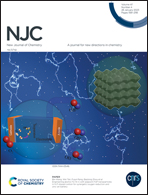Photocatalytic splitting of H2O-to-H2O2 by BiOI/g-C3N4/CoP S-scheme heterojunctions
Abstract
Photocatalytic H2O-to-H2(g) and –H2O2(aq) (2H2O(l) → H2(g) + H2O2(aq)) by a two-electron reaction is kinetically feasible. The proton-coupled two-electron transfer induced a photocatalytic oxygen reduction reaction (ORR) from oxygen and water is also an accessible path for the safe production of H2O2. It is thus desirable to synthesize effective photocatalysts that yield H2O2 by the coupling of two-electron transfer water oxidation (+1.23 VNHE) and ORR (+0.68 VNHE). In this work, new g-C3N4/BiOI S-scheme heterojunctions with co-catalyst cobalt phosphide (CoP) (BiOI/g-C3N4/CoP) were prepared for the photocatalytic H2O-to-H2O2 reactions. The BiOI/g-C3N4/CoP heterojunctions can enhance visible light absorption and reduce electron–hole pair recombination rates. Because of the water splitting by two-electrons and reduction of oxygen, the BiOI/g-C3N4/CoP heterojunctions have a better photocatalytic H2O-to-H2O2 yield than with the BiOI/g-C3N4 heterojunction by 3.0–8.4 times. With more CoP (i.e., 19 wt%) on the BiOI/g-C3N4, the BiOI/g-C3N4/(CoP)0.19 heterojunction generates more photocatalytic H2O2 with higher formation rate constant (kf), equilbrium constant (K), and a lower decomposition rate constant (kd). This new, low-cost and ready-prepared BiOI/g-C3N4/CoP S-scheme heterojunction has a high efficiency for the reversible photocatalytic H2O-to-H2O2 reaction, which could be feasibly used for applications in H2O2-fuel cells for electricity using solar energy.



 Please wait while we load your content...
Please wait while we load your content...